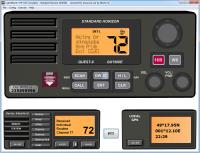Nautical Software .com
Order Now : 020 8405 8200

Marine VHF DSC Radio Simulator
Hands-On Radio Operating Experience
CLASS-D RADIO TRAINING SIMULATOR
This latest VHF DSC training simulator offers hands-on experience operating all the controls and functions of a Class-D radio. Class-D is the GMDSS specification for small-craft use, and excludes Distress Acknowledgement or Distress Relay functions. The Simulator can send or receive every type of Digital Selective Calling alert, using a "remote station" control panel to monitor outgoing alerts and generate incoming alerts.
Simulator Description
The VHF DSC Radio Simulator is PC software, supplied by internet download. The program must be installed to the hard drive of the computer and is then launched from its desktop icon when required. At launch, you have a main VHF radio set with all its major functions operating exactly as a real radio. You also have a simulated remote radio, as described below, and a GPS Simulator.
Generic Radio Training
The particular radio chosen for this Simulator is a faithful model of the real equipment, which is one of the most popular sets on the market, Standard Horizon GX1500. It can be used for generic training, not just to teach operation of the specific radio set.
Essential Practice
You may wonder why a Simulator is required, if you have a real VHF radio on your boat. Real practice is good, but the most important operations, Urgency and Distress, which you must know instinctively, are the very ones you cannot practice on live equipment. With this Simulator program, you can become proficient at sending and receiving every type of alert with no risk of false alerts - including the vital Urgency and Distress working.
Remote Station
Another limitation of a real radio is that you can only ever experience one end of a communication. The Simulator, in addition to your main set, has an extra "remote station" which can send and receive alerts. You choose and send alerts from the remote station and learn to handle them correctly on your main set. When you transmit any alert from your main radio, the details contained in the alert are displayed on the remote station, so you can see exactly the effect of your transmission. In addition to the range of DSC Alerts allowed on Class D equipment, the remote station also provides a Distress Acknowledgement option, so you can experience how this stage of distress working is conducted.
GPS Simulator
Along with the remote station, there is a GPS Simulator, which can transmit a position and time to your main radio. The GPS simulates a cruise around a selected area and the positions will be included in the appropriate alerts when you send them. The GPS Simulator is switchable, so that you learn what happens with, or without a valid GPS signal input to the radio. You can also learn to input your position and time manually, if the GPS signal fails for any reason.
SOS Button
It is vital that you understand the procedure for issuing a DSC Distress Alert, using the SOS button. Every step in this process can be practised, to ensure you can perform the procedures in stressful situations.
Extensive Video Tutorials
The Help menu of the program includes a large number of video tutorials, in MP4 Movie format. These are different from the interactive VHF DSC Tutor software product. There are video tutorials to assist with installing and running the Simulator, plus descriptions of every important procedure on the simulated radio.
PC Requirements to Run the VHF Radio Simulator
- Windows™ 7, 10, or 11
- 40Mb Hard Drive Space for software plus 500Mb for video tutorials
- 1Gb RAM
- Loudspeaker or headphones - for alarm tones and video tutorials
- Internet Connection or USB socket - for program installation

